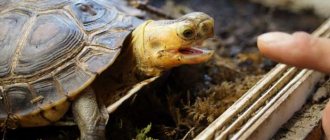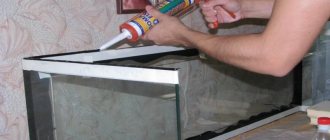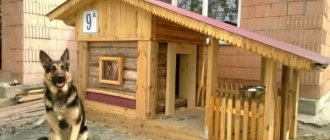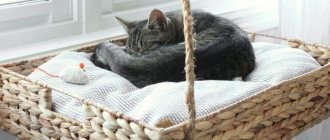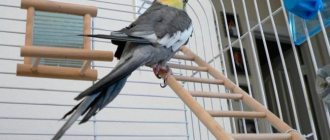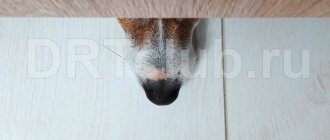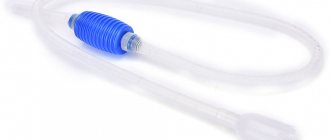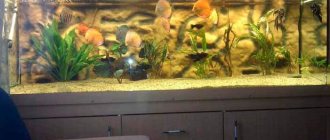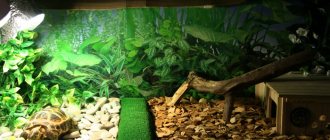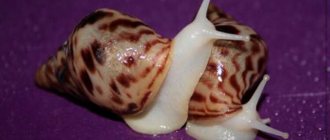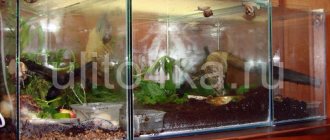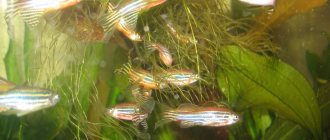Achatina are truly unique and interesting creatures. This type of snail is gaining more and more popularity as pets every year. However, before you become the owner of these exotic muskies for the first time, the issue of keeping them at home should be carefully studied. In addition to the specifics of care, there are certain nuances of maintenance, for example, a terrarium for snails.
Achatina requires no draft
How to build a terrarium for “Akhatinki” yourself
These mollusks like a subtropical, temperate climate, and even a slight drop in temperature can cause their death. Therefore, owners must provide their pets with suitable conditions. In addition, Achatina requires a special tank - a terrarium, in which it is necessary to reproduce with maximum accuracy the environment familiar to these animals.
Many owners of Achatina use a regular aquarium; in it you can create an excellent imitation of natural conditions. In such a tank, the snail will be protected from drafts and cold air, it will remain at room temperature and it will be easy to maintain suitable humidity. The owner should be wary if his ward has become inactive - in this case, there is a risk of death of the Achatina, and most often this happens due to the inattentive attitude of the owner.
Humidity and temperature
These indicators will depend on what type of snail you have, however, the most comfortable temperature for snails will be 25 - 27 °C. Humidity should be maintained at approximately 80%. In order to monitor these indicators, you need to use special equipment; it is attached to the inner wall of the terrarium. In order to maintain the temperature, you can use a special thermal mat. To maintain humidity, you need to constantly spray the terrarium. The heating device must not be placed under the bottom of the terrarium; it must be located near the wall.
An ideal terrarium for Achatina snails
Many factors are important - from the size of the tank to its decor - after all, we are not talking about ordinary, but about exotic mollusks:
- When calculating the volume of the tank, it should be taken into account that one clam requires at least 10 liters. It is worth immediately taking into account that, although in captivity Achatina does not grow to the same gigantic size as in the natural environment, they are still quite large snails;
- for a 30-liter container, a couple of Achatina are enough - however, if they live in comfort, then you won’t have to wait long for the appearance of offspring;
- such a pet will not run away, but it may well crawl out of the tank, so it is advisable to provide it with a lid with holes - this will provide both protection and ventilation;
- the ideal size of a house for snails is a height of at least 20 cm, a width of 35 cm;
- direct sunlight is harmful to Achatina, they can lead to the death of the pet, so the terrarium should be installed in a dark place;
- in a terrarium or aquarium, the bottom should be covered with a layer of soil - moss and coconut substrate are ideal for snails;
- Achatina should have several feeders - everyday food is placed in one, additional feeding is placed in the others: a grain mixture, a composition with eggshells, feed chalk, rolled oats, etc.;
- There must be a container for swimming - made of plastic material, with low sides and a small volume of water so that the snail does not choke (it will not splash or dive, it just enjoys being in the water);
- all tanks, bowls, etc. should be secured, otherwise the snail may turn everything over with an awkward movement;
- in order to maintain and monitor readings of temperature, humidity and other parameters, the container must be equipped with a thermometer, hydrometer and other instruments;
- The terrarium requires weekly general cleaning; to maintain constant cleanliness, you can prepare a sponge with good absorbent properties.
Special attention should be paid to the soil, as it performs several important functions at once:
- maintains humidity in the tank - to do this, it is enough to spray it 2-3 times during the day;
- many Achatina prefer to rest during the day, buried in the soil - therefore its layer should be thick enough and the consistency should be loose;
- the substrate is also a place for laying eggs - it makes the future offspring cozy and warm;
- the soil eliminates cases of injury to snails when they slide off the walls or lid of the tank and fall to the bottom (it often happens that when falling from a height, Achatina’s shell breaks and the animal dies).
Types of soil
To make living conditions comfortable, you need to know how to equip the utilitarian from the inside. The soil should have a thickness of 6-7 cm and be loose and soft in consistency. This will help avoid chips and cracks if the animal accidentally falls from the walls of its home.
Suitable
Best options for soil:
- moss is one of the favorite bedding options for mollusks;
- peat is a budget option, good in combination with other types of soil;
- fallen leaves - can be an independent or additional option;
- coconut substrates are inexpensive and most popular;
- bark of certain types of trees;
- earth with low acidity (as for violets).
Soils that can store moisture well and allow the mollusk to burrow inside are also suitable.
Prohibited
Sawdust and sand are strictly prohibited. The former very quickly oxidize the mollusk shell. Because of this, the shell becomes covered with a white coating, which is extremely difficult to clean off. Sand can also cause scratches on the shell. But it is most dangerous when swallowed with food; it may not completely exit the esophagus.
Read more about choosing soil for Achatina snails in this article.
Container as a terrarium
Many Achatina owners take the simple route and keep their African charges not in terrarium aquariums, but in plastic boxes. How suitable is such housing for exotic snails? As it turns out, a container is an excellent option when it comes to a 30-40 liter container. The ideal option is a transparent box with a removable lid and holes that provide adequate ventilation.
The minimum height of the walls of the tank is 20 cm, length - 30 cm. Naturally, if the owner is going to breed Achatina, he should take care of a spacious house for his inhabitants, the number of which will increase over time.
As in a terrarium, the container must be maintained at a certain humidity level and the container should not be placed in the sun. In no case should shellfish bask in direct sunlight - this will cause dehydration of the animal and its death.
If the snail's house is an ordinary container, a box should be placed in it, the bottom of which should be covered with substrate. The thickness of the substrate layer for large snails should be at least 10 cm.
For these purposes, you can buy a package of special soil or loose sand at a pet or gardening store. When choosing a suitable substrate, you should focus on the pH of the composition, which is usually indicated on the package. It is best if this indicator is 7.0. If you place soil with low acidity in a tank containing snails, this can damage the skin or shells of the inhabitants.
If soil from your own garden plot is used as soil, it must first be sterilized - in a hot oven or refrigerator. Otherwise, infection or parasites may enter the house.
Plastic or glass?
In general, the material of the terrarium will not play a role, however, it must have a lid. If the terrarium is glass, then it will be more transparent, making it easier to observe the mollusk, such a terrarium will be easier to fit into the interior, and also to decorate with lighting. But this terrarium will cost much more than a plastic one, and it is also more difficult to ensure proper ventilation in glass. This is why Achatina is often kept in plastic containers, which are sold in absolutely any hardware store.
Setting up a snail house
The owner of African snails can approach the issue creatively and independently arrange the home of his pets. In this case, you can think of comfortable conditions for both daytime and nighttime recreation.
The basis of a homemade house can be pottery shards, pebbles, and shells. You can line one part of the tank with soil, the other with decor, since some of the Achatina love soil, while others have a weakness for stones. Already while observing the mollusk, the owner will be able to understand its preferences.
You can use a small saucer as a container for water; the snail can climb into it without the risk of drowning. It is advisable to plant the terrarium with living vegetation - ivy, ferns, moss. These plants thrive in environments with high humidity. Ivy is an excellent solution for modest-sized containers.
Types of houses for Achatina
Several options may be suitable as an utilitarian:
- Aquarium for fish. It is good because it uses environmentally friendly material – glass. In addition, it is not difficult to buy it - it is sold in any pet market. However, ventilation problems may arise.
- Terrarium. This option will also most likely require solving the ventilation issue. Disadvantages include high cost, high weight and reduced impact resistance. But glass is chemically neutral and more transparent than plastic.
- Plastic container. In this case, there will be no problems with ventilation. To make a terrarium for snails ventilated, it is enough to drill two small holes from 5 to 6 mm on two opposite sides. Holes are drilled on one wall 3-4 cm from the top edge, on the other - 3-4 cm from the base.
You need to take a close look at the quality of the plastic itself. It is important that it is labeled “food grade”. The obvious advantage of plastic containers for Achatina snails is their budget cost. You can buy it even with a limited supply of funds. In addition, there is always a wide selection of shapes and sizes, impact resistance, ease of operation, and low weight. Another plus is that plastic heats up slowly and has poor thermal conductivity, so your pet will avoid sudden temperature changes.
- Another option is a homemade ulitharium. But to make it practical and convenient, you will need to know the principles described above. At the same time, houses made of plywood and cardboard are definitely not suitable.
It can also be noted here that Achatina is a mollusk with a terrestrial lifestyle. This means that the best option would be a horizontal terrarium for snails.
Tank cover
It is important that the Achatina house is regularly ventilated, and that the humidity in it is stable. And if the container is not covered, then the aeration will be too strong, as a result, the humidity will steadily decrease. A lid will help solve these problems; in order for moderate ventilation to continue, there must be holes in it. They can also be done using an awl and in the walls of the tank itself.
You can make a window in the lid of the container and block it with a piece of mosquito net, gluing it on the outside with superglue. It is important that occupants do not come into contact with the adhesive. This precaution will prevent insects from entering the terrarium. The soil should always be clean, moderately moist, but not soggy.
If regular spraying of water does not help, and the air in the tank quickly becomes dry, then you can cover the holes in the walls or lid with plastic film, which will provide a “bath” effect.
Selecting a primer
Soil performs certain functions. Based on them, you should decide what and how to choose soil for the terrarium. In terms of quality, it must correspond to its purpose:
- Achatina sleeps in the soil, lays eggs, and digs through it in search of food;
- the soil is saturated with moisture and retains it, which helps maintain a constant level of humidity;
- if an animal falls off the wall of an artificial dwelling and falls to the bottom, the soil will soften the fall;
- Living vegetation is planted in the ground.
The substrate must be kept moist at all times, and the soil should be loosened regularly. In addition, it must be safe for shellfish - no fertilizers or parasites.
In African snails, due to their inherent rapid metabolism, the soil quickly becomes dirty with waste products. Therefore, it is important that changing it is easy and quick. Experienced snail breeders know this life hack:
- Take a plastic bag with a bottom that is equal in area to or slightly larger than the bottom of the terrarium.
- The bottom is cut off from the bag with “sides”.
- The bag is placed at the bottom of the terrarium, and soil is poured into it.
- The edges can be camouflaged with snags, dry leaves and moss.
Thus, to clean the terrarium for Achatina, you just need to remove the bag of soil and replace the entire structure with a new and clean one.
How to care for domestic Achatina
Giant African snails have significant advantages - they are quiet, non-messy and odorless pets that do not require regular walks and other activities. But this does not mean that they do not require care:
- the house of exotic inhabitants must be thoroughly cleaned once a week;
- Achatina is bathed - carefully, without a contrast shower, spraying them with a spray bottle. Both hot and cool water can harm shellfish;
- The snail's shell needs special care - it must be examined for diseases and damage; if plaque, stains, chips, or cracks are detected, it is recommended to consult a specialist;
- if it is not possible to visit a veterinary clinic or there is no specialist involved in the treatment of mollusks, you can use a non-toxic adhesive.
It is recommended to care for the Achatina shell as follows:
- strengthen its material - in order for the shell to be strong and resistant to various types of damage, it is recommended to treat it with a mixture of calcium or crushed shells;
- damage to the shell of snails can heal without outside help, but in order to stimulate the process, they can be sealed with non-toxic glue or a layer of plaster;
- many snails are quite aggressive animals and are capable of chewing off the limbs of other inhabitants of the tank. Snails, which seem like a “delicacy” to neighbors, should smear their shells with Vaseline to discourage the voracious residents’ appetite;
- A preventive measure is to treat the terrarium with a weak solution of potassium permanganate. This avoids the development of mites and fungi in the container.
Selection of accessories and plants
You can beautifully decorate an aquarium for a clam with your own hands using live and artificial vegetation, decorations and decorations. When choosing decorations, it is important to make sure that they are made from environmentally friendly materials and are safe for your pet’s health. In addition, jewelry should not have sharp edges, otherwise Achatina will injure its delicate body. The following will look harmonious in the terrarium:
- Cones, twigs and driftwood, pre-treated from bacteria or purchased in a store.
- Moss – decorative or forest. If the moss is brought from the forest, it is soaked for 12 hours in cool water, scalded with boiling water and laid on top of the substrate.
- Living types of flora: ivy, ferns, mosses, juveniles. When planting living flora, you should be prepared for the fact that some of the plants will be gnawed by Achatina. Artificial flora is considered a more economical and practical option.
When choosing decorations, you should avoid hard and rigid objects with sharp edges.
In an aquarium with Achatina, be sure to place a bowl of clean water, because snails love to take water treatments. Choose a medium-sized bowl that is stable so that the container does not tip over.
African Achatina are funny and intelligent pets that get used to their owner and recognize the owner by allowing themselves to be stroked. For a long life, the mollusk should be provided with a properly equipped house in which the snail will be calm and comfortable.
Features of caring for Achatina offspring
The clutch of snails is located in the thickness of the substrate all the time until the babies appear. The environment should be moist - if the soil is dry, the eggs most often die. It is not worthwhile to moisten the soil, as this can cause the death of offspring. The optimal air temperature for snails is 28°C. You should not touch the eggs with your hands, as the delicate shells can be easily damaged.
The next stage: caring for young Achatina. Individuals do not require any complex procedures. One mollusk can lay up to 75% of the eggs, and three weeks later, snails hatch from them. In some cases, it can take 4 weeks from the moment the eggs are laid until the babies hatch.
The offspring are separated from their parents, and when the young grow up, the individuals are placed in different tanks - this will prevent uncontrolled mating and reproduction.
Ventilation
African land mollusks require humidity and fresh air for normal development and comfort. Regular supply of oxygen will help optimize the level of humidity and reduce the risk of mold, rot and pathogens.
To create proper ventilation, holes are made in the container where the snails live. The holes must be correctly located: on one side of the container, round holes are made at the top, on the other, at the bottom. The temperature in the house should be 24-27C. Creating optimal conditions will also help extend the lifespan of the Achatina snail.
We decorate the terrarium with natural materials
You can add beauty and natural beauty to your landscape using bark, branches, pine cones and living plants.
The Achatina snail often burrows into the ground under branches or snags, so you can find interesting branches yourself in the forest, or you can buy them at a pet store. If you find a snag or branch, be sure to wash it and fry it for 10 minutes in the microwave.
A large piece of bark will add mystery to the terrarium, which you can also pick up in the forest or planting. It should also be treated before placing it in the Achatina dwelling. The snails will rest in an artificial shelter made from a piece of bark.
You can spread moss on top of the soil. Forest moss can be collected in the forest, but it should be soaked in cold water for 10 hours, then doused with boiling water and only then laid out in a terrarium like a carpet or made into fancy mounds.
Sphagnum moss is sold at pet stores and does not require additional processing. Serves as a beautiful green bedding. In addition to the moss, place a few spruce cones to give the forest landscape a complete look.
You can use half a coconut as an artificial shelter for the snail to rest during the day. Laying dry oak or birch leaves nearby.
Don't forget about living plants that thrive in moist soil.
- traditionalism;
- young;
- Money Tree;
- fern;
- ivy;
- mustard;
- barley;
- wheat.
Living plants will have to be renewed from time to time, as snails will eat them. Replacements will require driftwood and branches, bark and moss, all natural materials that lose their attractive appearance in a humid, warm environment. This way the decor in your terrarium will always be new.
How to choose a place for a container with snails.
Direct sunlight is contraindicated for Achatina, so you can place the terrarium on a bedside table or shelf away from sunlight and drafts. Do not place the snails' home near a radiator or radiator, as they will get too hot and may die.
Decorate the container on both sides with fresh flowers or artificial plants, let it be a corner of exoticism and relaxation.
